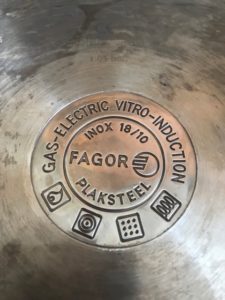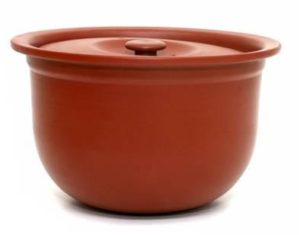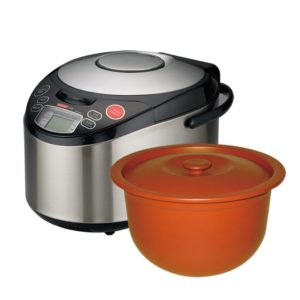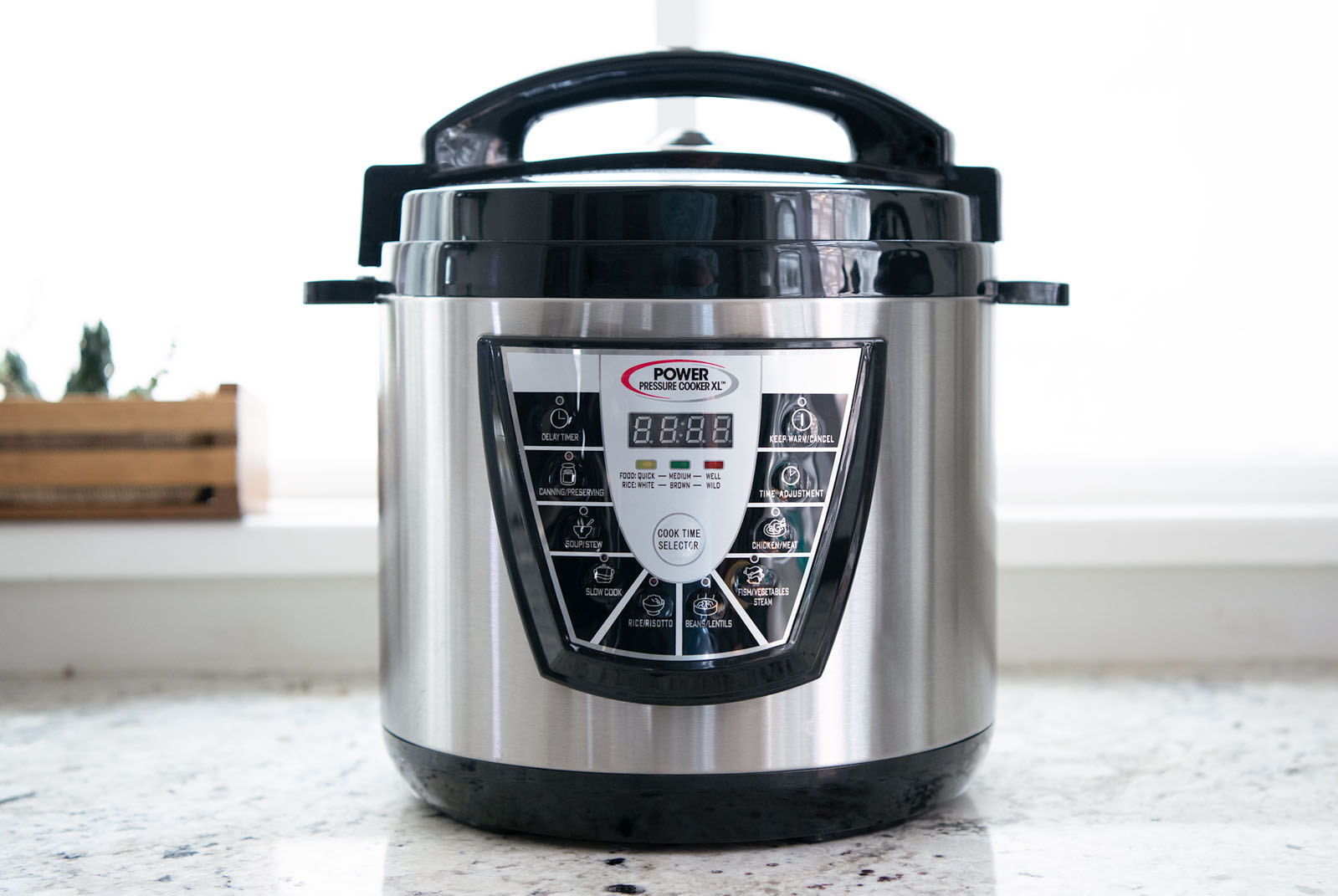When I learned about the dangers of aluminum cookware and non-stick coatings, I was eager to find safe alternatives that I could use without the risk of exposing my family to dangerous heavy metals or toxic chemicals.
 I began researching all the options: from stainless steel to glass, copper and ceramic. I made a lot of rice, so I wanted a rice cooker (they make the best rice!) but it was very difficult to find a rice cooker that was not non-stick-coated aluminum.
I began researching all the options: from stainless steel to glass, copper and ceramic. I made a lot of rice, so I wanted a rice cooker (they make the best rice!) but it was very difficult to find a rice cooker that was not non-stick-coated aluminum.
I first began looking for rice cookers with stainless steel inserts, because I knew that was safe. My research, however, led me to the facts, which are not always as simple as we think.
Stainless steel is safe… sometimes.
As with everything else, manufacturers eventually will cut corners and produce inferior products that save them money in production and increase their profits. Stainless steel is no different.
Instant Pots are all the craze right now–and why not? They make cooking easy, quick and fun again! They don’t heat up the house and they create delicious meals in minutes! They’re programmable and they come in huge sizes–perfect for any family! Most importantly, they are made of stainless steel, so they are completely safe!

Not so fast.
With every material, there is some kind of trade-off…so it’s good to be informed as to the benefits and the risks associated with each material.
I’m teaming up with Kara at Deep South Crunchy Mom and Sarah at Clean Living With Kids to bring you a series on truly safe cookware. We want you to have all of the information: risks and benefits, so you can decide for yourself what are the best materials for your family.
See Kara’s post about cast iron here,
And Sarah’s post about glass here.
What’s Wrong With Stainless Steel?
At first glance, stainless steel seems like the perfect solution: it’s hypo-allergenic, it doesn’t rust, it isn’t breakable, and it doesn’t have any heavy metal issues.
Upon closer examination, we will see that not all stainless steel is created equally.
Cheaper grades of stainless steel are not as pure as we have been led to believe, and they can leach nickel into our food. Nickel is a heavy metal, so this is not ideal. (Read more about nickel toxicity here).
How do I know if my stainless steel is safe?
It can be very difficult to determine what grade of stainless steel you are using…. and this is where it gets confusing. There are quite a few grades and classifications of stainless steel (read about them here), and each grade is a different combination of metal alloys.

Manufacturers don’t often disclose what grade of stainless steel they are using in the cookware that we buy at the store, but a general rule of thumb is: the more expensive it is, the higher grade it is.
In general, stainless steel cookware is either of the 300 or 400 series, and often you can see the grade stamped on the bottom of the pot. Usually these numbers look something like 18/10 (most common), which indicates it is 18% chromium and 10% nickel.
To me, 10% is a lot…especially when it can leach into my food. So I try not to use this kind of stainless steel on a regular basis. I have one stainless pan (pictured) that I use just for popcorn or for steaming things in a separate bowl inside of it.
I’d be particularly wary of cooking anything acidic (tomato sauces, anything with citrus) in low-grade stainless steel, as it would more readily leach the harmful nickel into your food, especially with high pressure or long cooking times.
Check your stainless steel pots and pans for this mark to see what grade your pots and pans are. They are likely this 304 18/10 grade, as that is the most common and most affordable. If you didn’t pay $300 to $400 for each of your pans, it’s not likely they are a high enough grade that would eliminate the nickel (18/0).
If Stainless Steel isn’t Safe, What Can I Use?
I know this is frustrating. It seems like nothing is safe any more, so why even bother? What can I even use?
I have a few things that I use that are safe:
- Glass (Corningware Visions is the most durable that I’ve used–see Sarah’s post on this on Clean Living with Kids)
- Cast Iron (See Kara’s post on this on Deep South Crunchy Mom)
- Unglazed Clay
 I’m also not a fan of glazed ceramic, like is used in slow cookers and other baking dishes, because it has been found that trace amounts of lead exist in all of those glazes. Now, trace amounts might not matter too much when it’s in your drinking glass… but I don’t want my hot food stewing in something that has any lead in it for hours on end.
I’m also not a fan of glazed ceramic, like is used in slow cookers and other baking dishes, because it has been found that trace amounts of lead exist in all of those glazes. Now, trace amounts might not matter too much when it’s in your drinking glass… but I don’t want my hot food stewing in something that has any lead in it for hours on end.
So in my house, I primarily use these three materials, and my favorite is clay.
Unglazed clay is great for a lot of reasons, and my favorite way to cook with it is VitaClay.
- Pure Zisha clay has no lead or heavy metals (3rd party lab verified)
- No glaze means no added lead
- Clay has excellent thermal heat retention properties
- Clay has excellent nutrient retention properties
- Clay preserves texture and flavor better than any other material
- Clay employs infrared heat to cook the food faster and more safely than other methods
 VitaClay is my favorite because it is a multi-cooker, and it makes cooking easy, quick, safe, and non-toxic! Plus it doesn’t heat up the house or run up the utility bills.
VitaClay is my favorite because it is a multi-cooker, and it makes cooking easy, quick, safe, and non-toxic! Plus it doesn’t heat up the house or run up the utility bills.
VitaClay is a slow cooker, rice cooker, yogurt maker, broth maker, steamer, and reheater in one. It can do almost all of my cooking tasks quickly and more easily than with other methods.
The food in VitaClay comes out tasting better than cooking with any other material I’ve used, including stainless steel, non-stick, glass and cast iron. For some reason, food just tastes better when cooked in clay.
VitaClay is the best of all worlds–delivering safe, delicious food, home-cooked without the hassles, the stress or the mess. Most meals can be put together in less than 10 minutes, then VitaClay takes over, and dinner is ready when I am. It even has a preset feature that allows me to have steel-cut oats ready when I wake up in the morning!
And if you’re still thinking that Instant Pot will cook your food faster and more easily, think again! We tested several dozen recipes in both VitaClay and Instant Pot, and in most cases, the meals were cooked faster (not to mention with better results) in VitaClay! Why? Because that “15 minute” recipe quickly becomes 55 minutes when you take into account the 20 minutes it takes to pressurize and the additional 20 minutes it takes to de-pressurize. VitaClay, not being a pressure cooker, has none of that extra time added on and still cooks 50-75% faster than other slow cookers and multi-cookers.
VitaClay is truly my favorite kitchen appliance: it has replaced my slow cooker, my rice cooker, my yogurt maker, my microwave, and my stock pot… just to name a few. And the results are always better in clay.
Right now you can get 10% off any VitaClay cooker on the website with code NOURISH10 at checkout. So start saving today! If you’d rather order from Amazon, check it out here.
And please, if you do decide to use the Instant Pot or other pressure cooker, always follow these safety tips to avoid explosions, burns or serious injury.
Resources:
Here is more information about Stainless Steel Cookware and the different grades that can be found.
Here is the 3rd party lab testing that has been done to ensure the unglazed clay used in VitaClay pots is free of lead and other heavy metals.
Check out Kara’s post at Deep South Crunchy Mom about the benefits of cast iron and why you should replace your non-stick pans STAT.
Check out the post from Sarah at Clean Living with Kids on glass bakeware and why glass is a great cookware option opposed to glazed ceramic, aluminum or other non-stick options.
New to Freedom & Coffee? Start here.
Disclosures:
Many of the product links in this post are affiliate links, which means I will receive a small commission from any purchase. I only recommend products that I love and this is at no extra cost to you. Thank you for supporting our mission with your clicks!



Hi Leah,
In regards to the above comments on lead and nickel leaching, would it be possible to employ another test facility to ensure complete safety? Perhaps newer equipment or processes in testing would change the outcome?
Very interested in knowing this answer. I am looking to restock my kitchen to only the healthiest tools and utensils available.
Hi! Are you talking about testing for the instantpot or VitaClay?
There has been pretty thorough testing that has found any lower grade of stainless steel can leach these metals. And I’ve seen regular reports from a 3rd party lab in San Francisco for VitaClay, so i’m not sure what additional testing would find, but if you have access to a good lab that you trust I’m sure that could be arranged.
is it harder to clean than stainless steel?
Hi Laura,
I’ve found in terms of cleaning, the clay pot is about the same as stainless steel. I wash it out with natural dish detergent and a brush. Just like with stainless steel, if i get some burny/sticky food at the bottom i boil baking soda in water in it for a little while and it comes right up. I also put mine in the dishwasher (though I believe the manufacturer doesn’t recommend that–i haven’t had a problem. just make sure it’s clear of other dishes so it doesn’t get chipped). I find the clay pot to be more non-stick than stainless steel (though there are no non-stick coatings–it is that way due to the “glazing” process in which they use only very high heat and water).
I just did some online research of the VitaClay cookware. Tamara Rubin does lead testing on products. Check out her test results of the Vita Clay cooker. There is a low lead count in the actual clay insert, and a very high lead count in some of the other components. Also nickel. Buyer beware: the claim of no lead in this product is false.
Not true: VitaClay does 3rd party batch testing and comes out clean. Here is the report on their website, and I can contact the owner and get a more recent one if you’d like to see it.
https://vitaclaychef.com/pages/trash-toxins
I’ve also tested the pots myself and they test negative for lead as well. I wouldn’t use them or recommend them if they did.
What does test positive for nickel is the stainless steel used in the InstantPots and glazed ceramics such as those used in crock pots test positive for trace lead.
The lead comes from the glaze, and VitaClay is unglazed. They test 99.9% free of lead… because that’s as accurate as the tests can get.
Here is another test report. They do them often I haven’t seen one yet that has any lead, cadmium, mercury or nickel detected.
https://vitaclaychef.com/pages/anresco-certificate-of-analysis